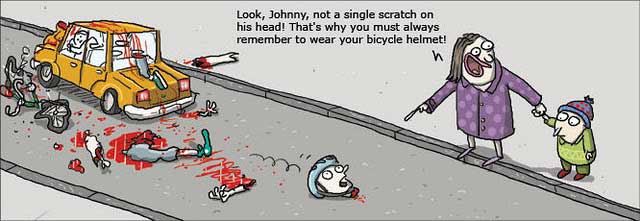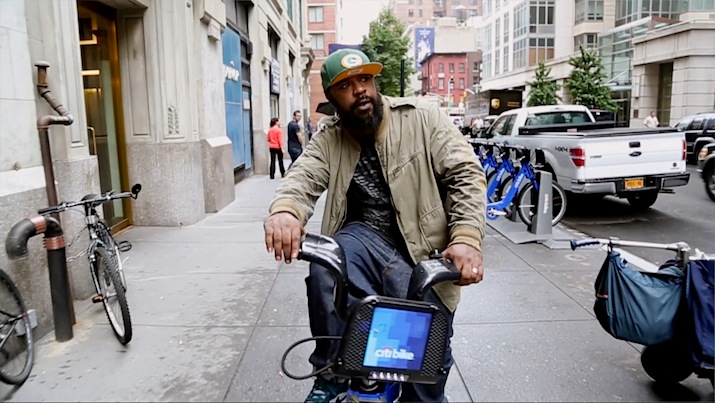Here we go again
 Fri, September 30, 2016
Fri, September 30, 2016 
A brand new study shows that bicycle helmets reduce the risk of serious head injury by 70%. How about a worthwhile study into the actual cause of death of every cycling casualty. Were they wearing a helmet, and if not, would a helmet have prevented that death anyway?
Because if a cyclist is hit by a motorized vehicle doing 60 mph, he will most likely die from blunt force trauma to both the body and head whatever he is wearing. The same goes if he is crushed under the wheels of a vehicle. Does a study like this conclude that someone so crushed and dead, but avoided head injury because they wore a helmet. Does that count as a win for the helmet?
Wear a dozen woolen hats, each stretched over the next, and that too would probably reduce the risk of head injury, but that is not the issue. Studies like this just make it easier for legislators to make helmet use mandatory, and harder for those opposed to argue against.
I am not against helmet use, I wear one myself, but I am definitely against being compelled to wear one. Why not helmets for pedestrians, as more of them are hit by cars and die than cyclists. How about the elderly, they are always tripping and falling?
How about mandatory bullet proof vests for everyone, as about 10 times more people are shot to death in the US than are killed on a bicycle. We could start with bullet proof vests for school kids, and people shopping in malls. That would cut down the number of fatalities in the event of a mass shooting.
I am being facetious of course, but is it just me or can anyone else see how ludicrous it is to single out the cyclist to wear protective gear. To make him wear it under the threat of a fine, or by peer pressure from other cyclists.
It is a distraction that diverts attention from the real problem of people driving carelessly.






























Statistics
37.8 % of all statistics are made up on the spot by the 26.9% of statisticians who are in the ball park when they should be back at the office gathering facts to back up their statistics.
I can vouch for the validity of those figures because I just made them up. Whether or not you find that funny will depend on your falling into the 49.3% of people who are skeptical over statistics.
The thing that makes something funny is when a statement contains a modicum of truth, and the point here is that some of us are skeptical of certain statistics. Whether we buy into them depends on our opinions to begin with.
Here is one I see all the time:
I’m not sure where this one started, but it has been around for thirty years or more and I’m assuming that originally it had some other statistics and solid data to back up that figure.
It has been repeated over, and over again so many times, that it is now stated as fact without reference to the original study. When you analyze the 85% all it does is reinforce a person’s view that bike helmets are a good idea, only if that person held that view to begin with.
Without the original study and the data to back it up, 85% is as meaningless a number as the ones I made up at the start of this piece. Like many statistics, the number is big enough that it sounds good, but not too big. This makes it believable if you don't give it too much thought. I think this has given this particular statistic its longevity.
I don’t even know any more if wearing a helmet is supposed to reduce injury by 85% or does it reduce death by 85%? People have accidents with and without helmets, some are injured and some die, but can anyone prove to me that it is even close to 85% survivor and 15% casualty rate.
Debates about helmet use can become as passionate as any religious or political debates. One argument is that helmets make cycling appear more dangerous than it really is. Around 800 cyclists are killed each year on US streets and highways. (A little over 2 per day.) A small number compared to the 100 or more people who die each day in automobiles. (These are statistics that a simple Google search will confirm.)
Of course far more people drive cars than ride bikes, but even so in a country with a population well over 300 million, slightly more than two cycling deaths a day is not what I would label a dangerous activity. Unfortunately, the general population does not see it this way.
Jurors in civil cases often have a bias against cyclists. They view cycling on the public highways as a highly dangerous practice, and when people are perceived to engage in dangerous activities, juries tend to place some of the blame on the participant. This has a direct effect on the amount of compensation they award.
By voluntarily wearing a helmet you at least appear to a jury or an insurance adjuster to be someone who takes responsibility for their safety. They cannot award you less with the argument that you didn’t wear a helmet, therefore you contributed to your own injuries.
Unfortunately the 85% helmet statistic gives legislators fuel to press for mandatory helmet use for cyclists. While many more people die each year from a simple trip or slip and fall than from cycling related accidents.
During the bike-boom years of the 1970s, helmet manufacturers in the US saw an opportunity, and American cyclists being equipment conscious, accepted the helmet. It was however, decades later before the rest of the world followed suit. Even today the helmet is only accepted by cycling enthusiasts, not the general public.
Far more pedestrians and car drivers die each day from head injuries, yet no one suggests they should wear head protection. Maybe upon waking each morning we should place a helmet on our head before we even put slippers on our feet, not removing it until we return to bed that evening. Viewed in this light it makes the whole issue somewhat ludicrous.
Making helmets mandatory only re-enforces the general public’s view that cycling is dangerous. I still maintain that wearing a helmet should be a personal choice, making them mandatory stops some from taking up cycling in the first place.
Most start riding a bike without a helmet, a few will become serious and eventually buy a better bike and all the equipment that goes with it, which will probably include a helmet.
To sum up I wear a helmet because it offers some protection. I don’t believe it is even close to 85%, but wearing one can’t hurt. I may hit a pot hole and fall on my head, in which case my helmet may save me from serious injury. But a crash involving a motor vehicle? The best way to avoid injury there is to ride defensively and circumvent the collision altogether.
First posted in 2014. Accident figures have been updated to reflect today’s trends.